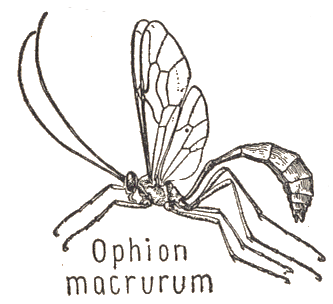
Every year, horror films are a bit more blood curdling than the year before. Yet, Hollywood is hard put to outdo nature, even though often purloining ideas from the wild world. At one end of the spectrum of behavior, cooperation and mutual benefit thrive, but at the other end, horrendous truth challenges the most imaginative fictional dread.
Many predators make their kills relatively quickly, but ichneumon wasps
harvest flesh in an especially gruesome manner from a human point of view. Penetrating
the larval body of its insect prey with a stiletto-sharp egg-laying mechanism, the
female wasp lays its egg inside its prey. Hatching, the wasp larva proceeds to feed on
fat and connective tissue of the host's body, but avoids vital organs--until, that
is, the host larva forms its cocoon. The wasp then feeds with a vengeance. Eventually
bursting from the empty husk, the wasp pupates and emerges to continue the cycle.
Horrible! Yet, we humans may appreciate that, more often than not, the wasp has removed
an insect pest that's no longer here to bedevil us. 
Contributor: Arthur H. Harris, Laboratory for Environmental Biology, Centennial Museum, University of Texas at El Paso.
Desert Diary is a joint production of the Centennial Museum and KTEP National Public Radio at the University of Texas at El Paso.

Ichneumon Wasp. After Lutz, 1921.